PEUGEOT 5008 2013 Owners Manual
Manufacturer: PEUGEOT, Model Year: 2013, Model line: 5008, Model: PEUGEOT 5008 2013Pages: 364, PDF Size: 16.24 MB
Page 131 of 364
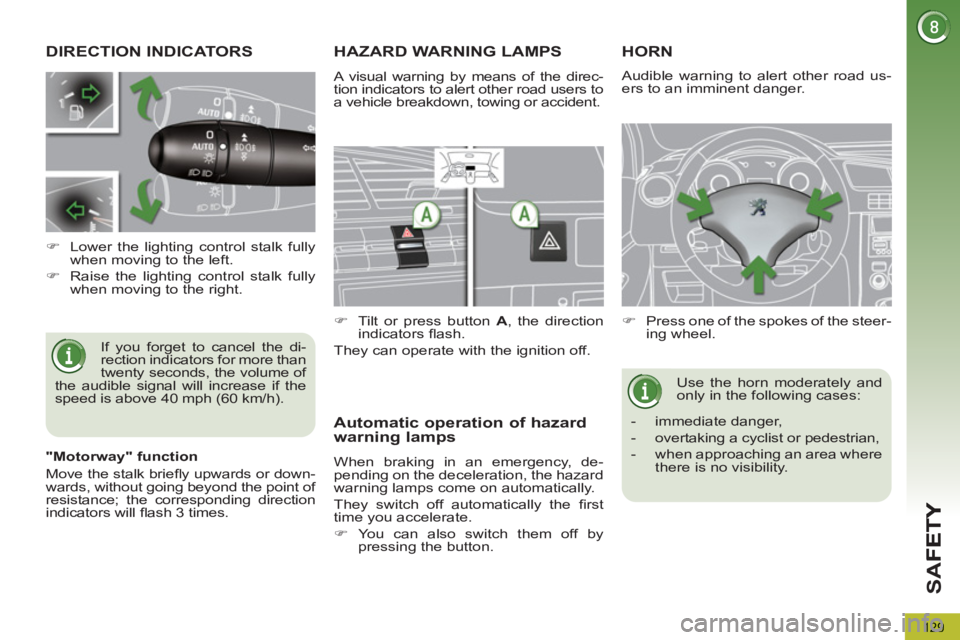
SA
F
129
DIRECTION INDICATORS
If you forget to cancel the di-
rection indicators for more than
twenty seconds, the volume of
the audible signal will increase if the
speed is above 40 mph (60 km/h).
�)
Lower the lighting control stalk fully
when moving to the left.
�)
Raise the lighting control stalk fully
when moving to the right.
HAZARD WARNING LAMPS
A visual warning by means of the direc-
tion indicators to alert other road users to
a vehicle breakdown, towing or accident.
�)
Tilt or press button A
, the direction
indicators fl ash.
They can operate with the ignition off.
Automatic operation of hazard
warning lamps
When braking in an emergency, de-
pending on the deceleration, the hazard
warning lamps come on automatically.
They switch off automatically the fi rst
time you accelerate.
�)
You can also switch them off by
pressing the button.
HORN
�)
Press one of the spokes of the steer-
ing wheel.
Use the horn moderately and
only in the following cases:
- immediate danger,
- overtaking a cyclist or pedestrian,
- when approaching an area where
there is no visibility.
Audible warning to alert other road us-
ers to an imminent danger.
"Motorway" function
Move the stalk briefl y upwards or down-
wards, without going beyond the point of
resistance; the corresponding direction
indicators will fl ash 3 times.
Page 132 of 364
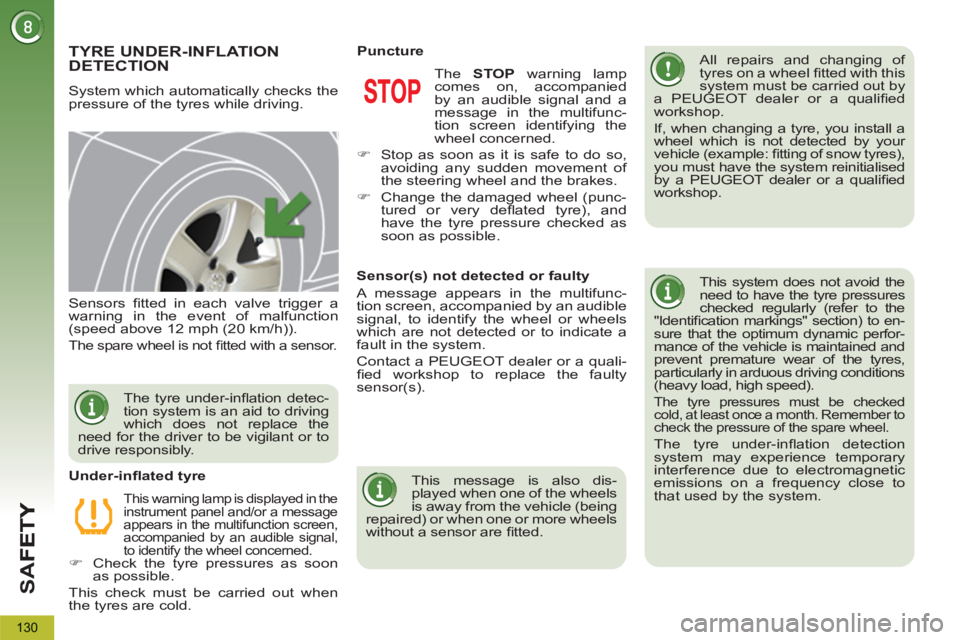
SA
F
130
TYRE UNDER-INFLATION DETECTION
System which automatically checks the
pressure of the tyres while driving.
All repairs and changing of
tyres on a wheel fi tted with this
system must be carried out by
a PEUGEOT dealer or a qualifi ed
workshop.
If, when changing a tyre, you install a
wheel which is not detected by your
vehicle (example: fi tting of snow tyres),
you must have the system reinitialised
by a PEUGEOT dealer or a qualifi ed
workshop.
This system does not avoid the
need to have the tyre pressures
checked regularly (refer to the
"Identifi cation markings" section) to en-
sure that the optimum dynamic perfor-
mance of the vehicle is maintained and
prevent premature wear of the tyres,
particularly in arduous driving conditions
(heavy load, high speed).
The tyre pressures must be checked
cold, at least once a month. Remember to
check the pressure of the spare wheel.
The tyre under-infl ation detection
system may experience temporary
interference due to electromagnetic
emissions on a frequency close to
that used by the system.
Sensors fi tted in each valve trigger a
warning in the event of malfunction
(speed above 12 mph (20 km/h)).
The spare wheel is not fi tted with a sensor.
This warning lamp is displayed in the
instrument panel and/or a message
appears in the multifunction screen,
accompanied by an audible signal,
to identify the wheel concerned.
�)
Check the tyre pressures as soon
as possible.
This check must be carried out when
the tyres are cold.
Under-infl ated tyre The STOP
warning lamp
comes on, accompanied
by an audible signal and a
message in the multifunc-
tion screen identifying the
wheel concerned.
�)
Stop as soon as it is safe to do so,
avoiding any sudden movement of
the steering wheel and the brakes.
�)
Change the damaged wheel (punc-
tured or very defl ated tyre), and
have the tyre pressure checked as
soon as possible.
Puncture
The tyre under-infl ation detec-
tion system is an aid to driving
which does not replace the
need for the driver to be vigilant or to
drive responsibly.
Sensor(s) not detected or faulty
A message appears in the multifunc-
tion screen, accompanied by an audible
signal, to identify the wheel or wheels
which are not detected or to indicate a
fault in the system.
Contact a PEUGEOT dealer or a quali-
fi ed workshop to replace the faulty
sensor(s).
This message is also dis-
played when one of the wheels
is away from the vehicle (being
repaired) or when one or more wheels
without a sensor are fi tted.
Page 133 of 364
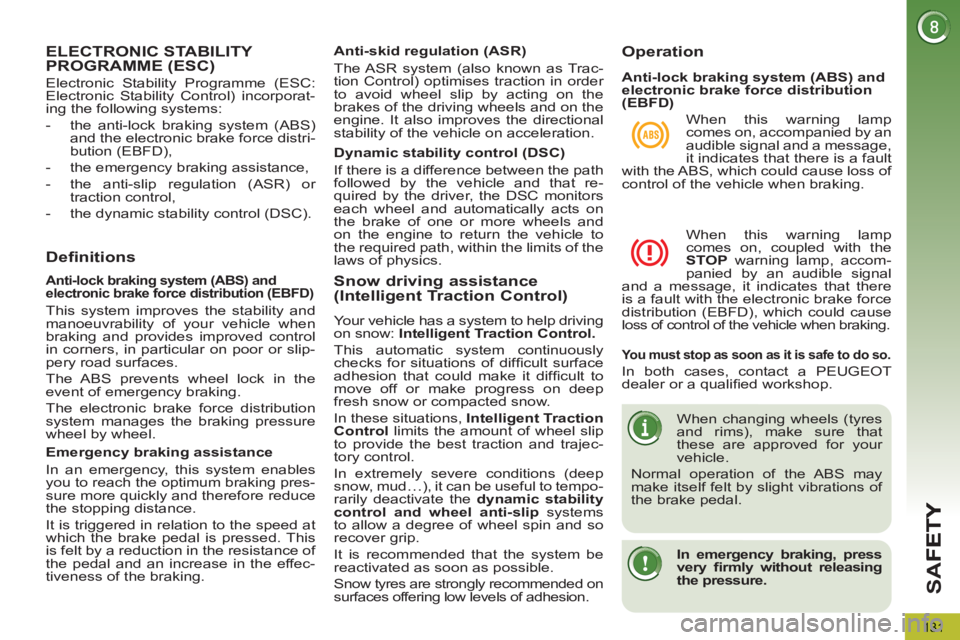
SA
F
131
ELECTRONIC STABILITY PROGRAMME (ESC)
Definitions
Anti-skid regulation (ASR)
The ASR system (also known as Trac-
tion Control) optimises traction in order
to avoid wheel slip by acting on the
brakes of the driving wheels and on the
engine. It also improves the directional
stability of the vehicle on acceleration.
Dynamic stability control (DSC)
If there is a difference between the path
followed by the vehicle and that re-
quired by the driver, the DSC monitors
each wheel and automatically acts on
the brake of one or more wheels and
on the engine to return the vehicle to
the required path, within the limits of the
laws of physics.
Emergency braking assistance
In an emergency, this system enables
you to reach the optimum braking pres-
sure more quickly and therefore reduce
the stopping distance.
It is triggered in relation to the speed at
which the brake pedal is pressed. This
is felt by a reduction in the resistance of
the pedal and an increase in the effec-
tiveness of the braking.
Anti-lock braking system (ABS) and
electronic brake force distribution (EBFD)
This system improves the stability and
manoeuvrability of your vehicle when
braking and provides improved control
in corners, in particular on poor or slip-
pery road surfaces.
The ABS prevents wheel lock in the
event of emergency braking.
The electronic brake force distribution
system manages the braking pressure
wheel by wheel.
Operation
When this warning lamp
comes on, accompanied by an
audible signal and a message,
it indicates that there is a fault
with the ABS, which could cause loss of
control of the vehicle when braking.
When this warning lamp
comes on, coupled with the
STOP
warning lamp, accom-
panied by an audible signal
and a message, it indicates that there
is a fault with the electronic brake force
distribution (EBFD), which could cause
loss of control of the vehicle when braking.
You must stop as soon as it is safe to do so.
In both cases, contact a PEUGEOT
dealer or a qualifi ed workshop.
When changing wheels (tyres
and rims), make sure that
these are approved for your
vehicle.
Normal operation of the ABS may
make itself felt by slight vibrations of
the brake pedal.
In emergency braking, press
very fi rmly without releasing
the pressure.
Anti-lock braking system (ABS) and
electronic brake force distribution
(EBFD)
Snow driving assistance(Intelligent Traction Control)
Your vehicle has a system to help driving
on snow: Intelligent Traction Control.
This automatic system continuously
checks for situations of diffi cult surface
adhesion that could make it diffi cult to
move off or make progress on deep
fresh snow or compacted snow.
In these situations, Intelligent Traction
Control
limits the amount of wheel slip
to provide the best traction and trajec-
tory control.
In extremely severe conditions (deep
snow, mud…), it can be useful to tempo-
rarily deactivate the dynamic stability
control and wheel anti-slip
systems
to allow a degree of wheel spin and so
recover grip.
It is recommended that the system be
reactivated as soon as possible.
Snow tyres are strongly recommended on
surfaces offering low levels of adhesion.
Electronic Stability Programme (ESC:
Electronic Stability Control) incorporat-
ing the following systems:
- the anti-lock braking system (ABS)
and the electronic brake force distri-
bution (EBFD),
- the emergency braking assistance,
- the anti-slip regulation (ASR) or
traction control,
- the dynamic stability control (DSC).
Page 134 of 364
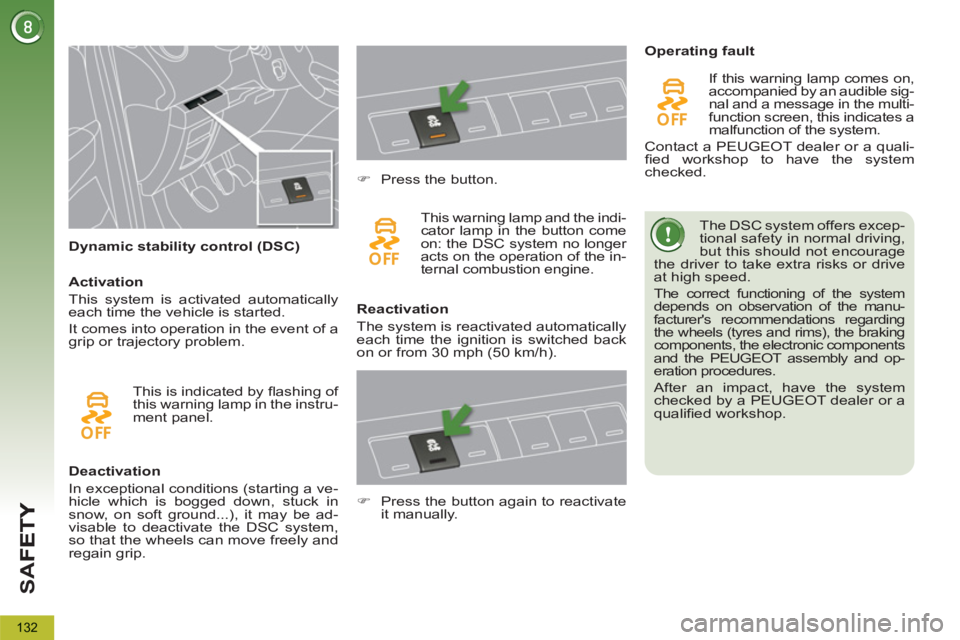
SA
F
132
Dynamic stability control (DSC) The DSC system offers excep-
tional safety in normal driving,
but this should not encourage
the driver to take extra risks or drive
at high speed.
The correct functioning of the system
depends on observation of the manu-
facturer's recommendations regarding
the wheels (tyres and rims), the braking
components, the electronic components
and the PEUGEOT assembly and op-
eration procedures.
After an impact, have the system
checked by a PEUGEOT dealer or a
qualifi ed workshop.
Deactivation
In exceptional conditions (starting a ve-
hicle which is bogged down, stuck in
snow, on soft ground...), it may be ad-
visable to deactivate the DSC system,
so that the wheels can move freely and
regain grip.
�)
Press the button.
This warning lamp and the indi-
cator lamp in the button come
on: the DSC system no longer
acts on the operation of the in-
ternal combustion engine.
Reactivation
The system is reactivated automatically
each time the ignition is switched back
on or from 30 mph (50 km/h).
Operating fault
If this warning lamp comes on,
accompanied by an audible sig-
nal and a message in the multi-
function screen, this indicates a
malfunction of the system.
Contact a PEUGEOT dealer or a quali-
fi ed workshop to have the system
checked.
This is indicated by fl ashing of
this warning lamp in the instru-
ment panel.
Activation
This system is activated automatically
each time the vehicle is started.
It comes into operation in the event of a
grip or trajectory problem.
�)
Press the button again to reactivate
it manually.
Page 135 of 364
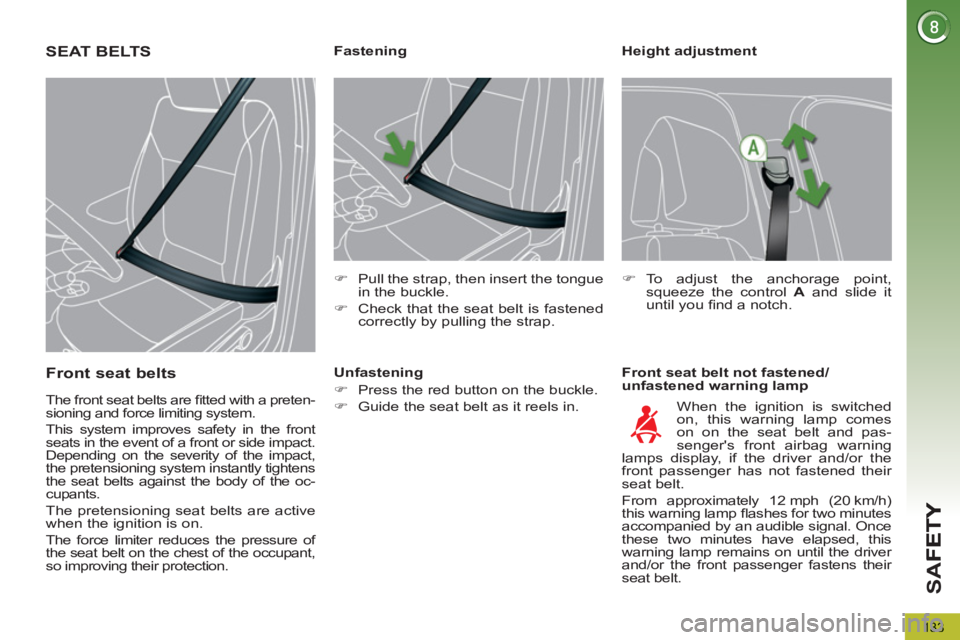
SA
F
133
Height adjustment
Front seat belt not fastened/
unfastened warning lamp
Fastening
�)
Pull the strap, then insert the tongue
in the buckle.
�)
Check that the seat belt is fastened
correctly by pulling the strap.
�)
To adjust the anchorage point,
squeeze the control A
and slide it
until you fi nd a notch.
When the ignition is switched
on, this warning lamp comes
on on the seat belt and pas-
senger's front airbag warning
lamps display, if the driver and/or the
front passenger has not fastened their
seat belt.
From approximately 12 mph (20 km/h)
this warning lamp fl ashes for two minutes
accompanied by an audible signal. Once
these two minutes have elapsed, this
warning lamp remains on until the driver
and/or the front passenger fastens their
seat belt.
Unfastening
�)
Press the red button on the buckle.
�)
Guide the seat belt as it reels in.
SEAT BELTS
Front seat belts
The front seat belts are fi tted with a preten-
sioning and force limiting system.
This system improves safety in the front
seats in the event of a front or side impact.
Depending on the severity of the impact,
the pretensioning system instantly tightens
the seat belts against the body of the oc-
cupants.
The pretensioning seat belts are active
when the ignition is on.
The force limiter reduces the pressure of
the seat belt on the chest of the occupant,
so improving their protection.
Page 136 of 364
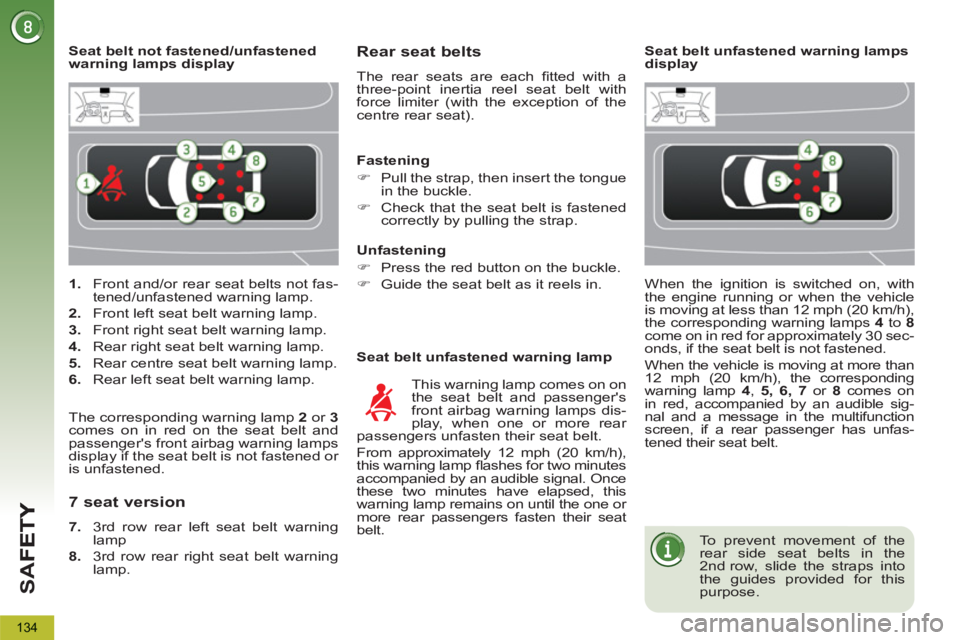
SA
F
134
1.
Front and/or rear seat belts not fas-
tened/unfastened warning lamp.
2.
Front left seat belt warning lamp.
3.
Front right seat belt warning lamp.
4.
Rear right seat belt warning lamp.
5.
Rear centre seat belt warning lamp.
6.
Rear left seat belt warning lamp.
Seat belt not fastened/unfastened
warning lamps display
Rear seat belts
The rear seats are each fi tted with a
three-point inertia reel seat belt with
force limiter (with the exception of the
centre rear seat).
Seat belt unfastened warning lamp
This warning lamp comes on on
the seat belt and passenger's
front airbag warning lamps dis-
play, when one or more rear
passengers unfasten their seat belt.
From approximately 12 mph (20 km/h),
this warning lamp fl ashes for two minutes
accompanied by an audible signal. Once
these two minutes have elapsed, this
warning lamp remains on until the one or
more rear passengers fasten their seat
belt.
Fastening
�)
Pull the strap, then insert the tongue
in the buckle.
�)
Check that the seat belt is fastened
correctly by pulling the strap.
Unfastening
�)
Press the red button on the buckle.
�)
Guide the seat belt as it reels in.
The corresponding warning lamp 2
or 3
comes on in red on the seat belt and
passenger's front airbag warning lamps
display if the seat belt is not fastened or
is unfastened.
7 seat version
7.
3 rd
row rear left seat belt warning
lamp
8.
3
rd
row rear right seat belt warning
lamp.
Seat belt unfastened warning lamps
display
When the ignition is switched on, with
the engine running or when the vehicle
is moving at less than 12 mph (20 km/h),
the corresponding warning lamps 4
to 8
come on in red for approximately 30 sec-
onds, if the seat belt is not fastened.
When the vehicle is moving at more than
12 mph (20 km/h), the corresponding
warning lamp 4
, 5, 6, 7
or 8
comes on
in red, accompanied by an audible sig-
nal and a message in the multifunction
screen, if a rear passenger has unfas-
tened their seat belt.
To prevent movement of the
rear side seat belts in the
2 nd row, slide the straps into
the guides provided for this
purpose.
Page 137 of 364
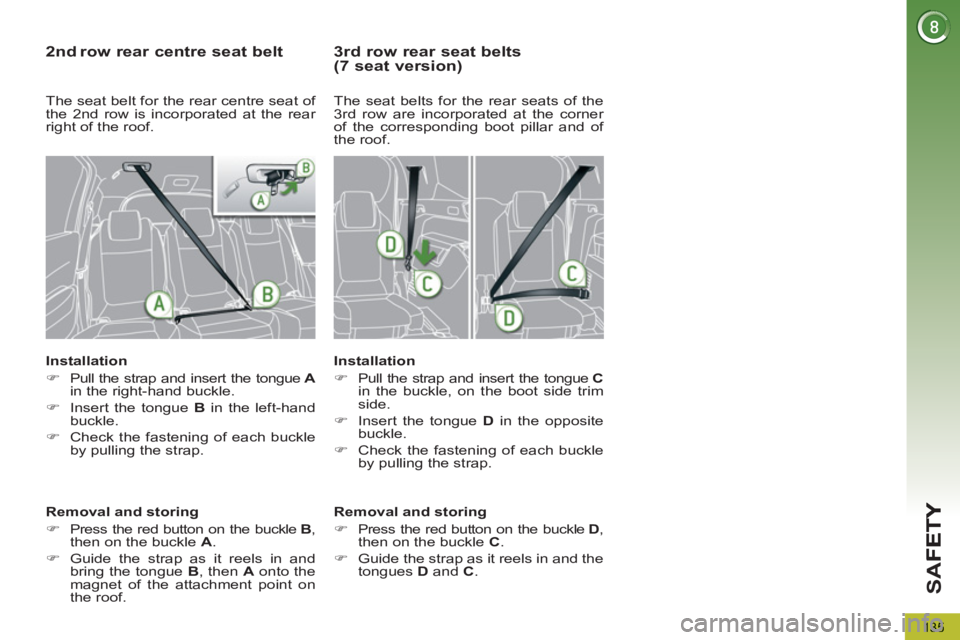
SA
F
135
2 ndrow rear centre seat belt
Installation
�)
Pull the strap and insert the tongue A
in the right-hand buckle.
�)
Insert the tongue B
in the left-hand
buckle.
�)
Check the fastening of each buckle
by pulling the strap.
Removal and storing
�)
Press the red button on the buckle B
,
then on the buckle A
.
�)
Guide the strap as it reels in and
bring the tongue B
, then A
onto the
magnet of the attachment point on
the roof.
3 rd row rear seat belts(7 seat version)
Installation
�)
Pull the strap and insert the tongue C
in the buckle, on the boot side trim
side.
�)
Insert the tongue D
in the opposite
buckle.
�)
Check the fastening of each buckle
by pulling the strap.
The seat belts for the rear seats of the
3
rd row are incorporated at the corner
of the corresponding boot pillar and of
the roof.
Removal and storing
�)
Press the red button on the buckle D
,
then on the buckle C
.
�)
Guide the strap as it reels in and the
tongues D
and C
.
The seat belt for the rear centre seat of
the 2 nd row is incorporated at the rear
right of the roof.
Page 138 of 364
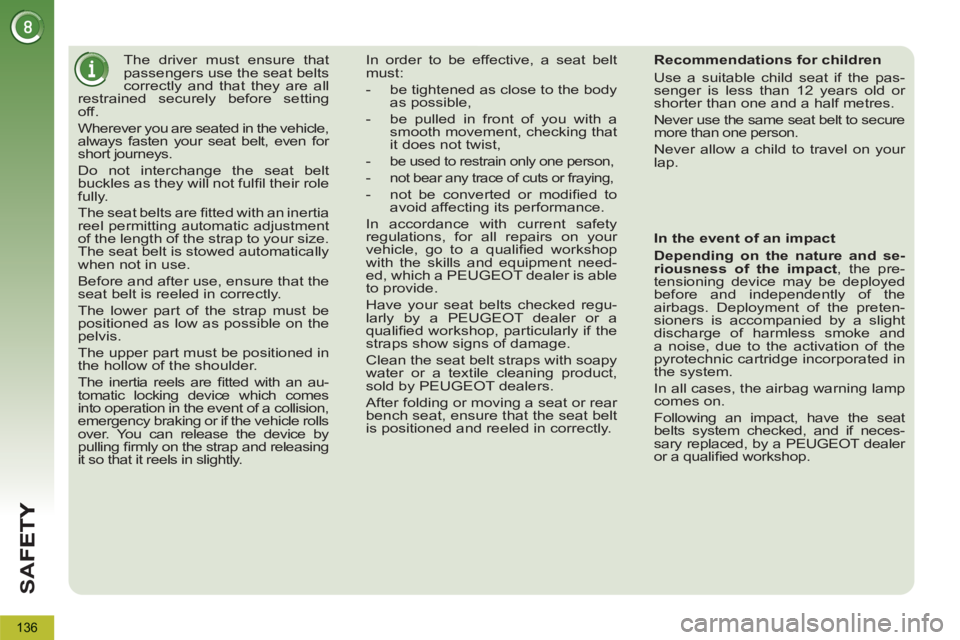
SA
F
136
The driver must ensure that
passengers use the seat belts
correctly and that they are all
restrained securely before setting
off.
Wherever you are seated in the vehicle,
always fasten your seat belt, even for
short journeys.
Do not interchange the seat belt
buckles as they will not fulfi l their role
fully.
The seat belts are fi tted with an inertia
reel permitting automatic adjustment
of the length of the strap to your size.
The seat belt is stowed automatically
when not in use.
Before and after use, ensure that the
seat belt is reeled in correctly.
The lower part of the strap must be
positioned as low as possible on the
pelvis.
The upper part must be positioned in
the hollow of the shoulder.
The inertia reels are fi tted with an au-
tomatic locking device which comes
into operation in the event of a collision,
emergency braking or if the vehicle rolls
over. You can release the device by
pulling fi rmly on the strap and releasing
it so that it reels in slightly. In order to be effective, a seat belt
must:
- be tightened as close to the body
as possible,
- be pulled in front of you with a
smooth movement, checking that
it does not twist,
-
be used to restrain only one person,
- not bear any trace of cuts or fraying,
- not be converted or modifi ed to
avoid affecting its performance.
In accordance with current safety
regulations, for all repairs on your
vehicle, go to a qualifi ed workshop
with the skills and equipment need-
ed, which a PEUGEOT dealer is able
to provide.
Have your seat belts checked regu-
larly by a PEUGEOT dealer or a
qualifi ed workshop, particularly if the
straps show signs of damage.
Clean the seat belt straps with soapy
water or a textile cleaning product,
sold by PEUGEOT dealers.
After folding or moving a seat or rear
bench seat, ensure that the seat belt
is positioned and reeled in correctly.
Recommendations for children
Use a suitable child seat if the pas-
senger is less than 12 years old or
shorter than one and a half metres.
Never use the same seat belt to secure
more than one person.
Never allow a child to travel on your
lap.
In the event of an impact
Depending on the nature and se-
riousness of the impact
, the pre-
tensioning device may be deployed
before and independently of the
airbags. Deployment of the preten-
sioners is accompanied by a slight
discharge of harmless smoke and
a noise, due to the activation of the
pyrotechnic cartridge incorporated in
the system.
In all cases, the airbag warning lamp
comes on.
Following an impact, have the seat
belts system checked, and if neces-
sary replaced, by a PEUGEOT dealer
or a qualifi ed workshop.
Page 139 of 364
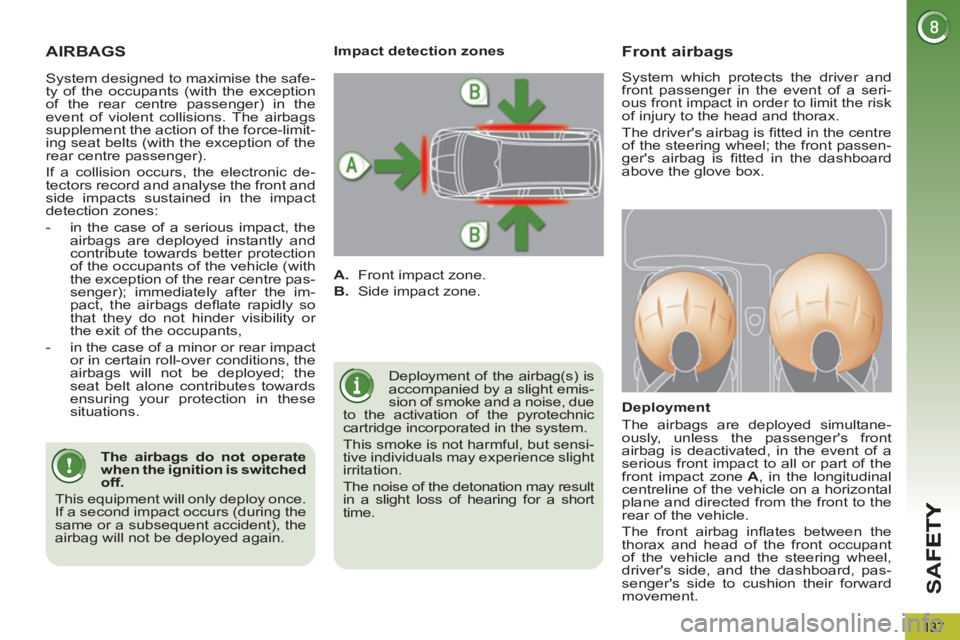
SA
F
137
AIRBAGS
Deployment of the airbag(s) is
accompanied by a slight emis-
sion of smoke and a noise, due
to the activation of the pyrotechnic
cartridge incorporated in the system.
This smoke is not harmful, but sensi-
tive individuals may experience slight
irritation.
The noise of the detonation may result
in a slight loss of hearing for a short
time.
Front airbags
Deployment
The airbags are deployed simultane-
ously, unless the passenger's front
airbag is deactivated, in the event of a
serious front impact to all or part of the
front impact zone A
, in the longitudinal
centreline of the vehicle on a horizontal
plane and directed from the front to the
rear of the vehicle.
The front airbag infl ates between the
thorax and head of the front occupant
of the vehicle and the steering wheel,
driver's side, and the dashboard, pas-
senger's side to cushion their forward
movement.
Impact detection zones
A.
Front impact zone.
B.
Side impact zone.
The airbags do not operate
when the ignition is switched
off.
This equipment will only deploy once.
If a second impact occurs (during the
same or a subsequent accident), the
airbag will not be deployed again.
System designed to maximise the safe-
ty of the occupants (with the exception
of the rear centre passenger) in the
event of violent collisions. The airbags
supplement the action of the force-limit-
ing seat belts (with the exception of the
rear centre passenger).
If a collision occurs, the electronic de-
tectors record and analyse the front and
side impacts sustained in the impact
detection zones:
- in the case of a serious impact, the
airbags are deployed instantly and
contribute towards better protection
of the occupants of the vehicle (with
the exception of the rear centre pas-
senger); immediately after the im-
pact, the airbags defl ate rapidly so
that they do not hinder visibility or
the exit of the occupants,
- in the case of a minor or rear impact
or in certain roll-over conditions, the
airbags will not be deployed; the
seat belt alone contributes towards
ensuring your protection in these
situations.
System which protects the driver and
front passenger in the event of a seri-
ous front impact in order to limit the risk
of injury to the head and thorax.
The driver's airbag is fi tted in the centre
of the steering wheel; the front passen-
ger's airbag is fi tted in the dashboard
above the glove box.
Page 140 of 364
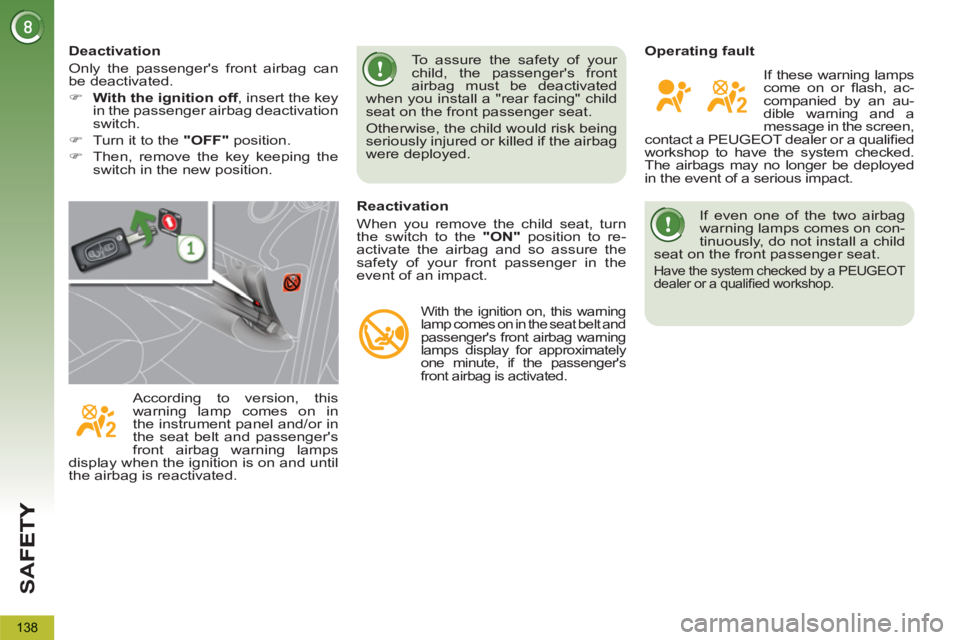
SA
F
138
If even one of the two airbag
warning lamps comes on con-
tinuously, do not install a child
seat on the front passenger seat.
Have the system checked by a PEUGEOT
dealer or a qualifi ed workshop.
Operating fault
If these warning lamps
come on or fl ash, ac-
companied by an au-
dible warning and a
message in the screen,
contact a PEUGEOT dealer or a qualifi ed
workshop to have the system checked.
The airbags may no longer be deployed
in the event of a serious impact.
Reactivation
When you remove the child seat, turn
the switch to the "ON"
position to re-
activate the airbag and so assure the
safety of your front passenger in the
event of an impact.
With the ignition on, this warning
lamp comes on in the seat belt and
passenger's front airbag warning
lamps display for approximately
one minute, if the passenger's
front airbag is activated.
To assure the safety of your
child, the passenger's front
airbag must be deactivated
when you install a "rear facing" child
seat on the front passenger seat.
Otherwise, the child would risk being
seriously injured or killed if the airbag
were deployed.
According to version, this
warning lamp comes on in
the instrument panel and/or in
the seat belt and passenger's
front airbag warning lamps
display when the ignition is on and until
the airbag is reactivated.
Deactivation
Only the passenger's front airbag can
be deactivated.
�)
With the ignition off
, insert the key
in the passenger airbag deactivation
switch.
�)
Turn it to the "OFF"
position.
�)
Then, remove the key keeping the
switch in the new position.